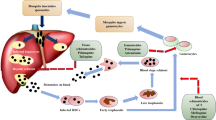Abstract
2,3-Diphosphoglycerate (2,3-DPG), an intracellular metabolite of glycolytic pathway is known to affect the oxygen binding capacity of haemoglobin and mechanical properties of the red blood cells. 2,3-DPG levels have been reported to be elevated during anaemic conditions including visceral leishmaniasis. 2,3-DPG activity in P. falciparum infected red blood cells, particularly in cells infected with different stages of the parasite and its relationship with structural integrity of the cells is not known. Chloroquine sensitive and resistant strains of P. falciparum were cultured in vitro and synchronized cultures of ring, trophozoite and schizont stage rich cells along with the uninfected control erythrocytes were assayed for 2,3-DPG activity and osmotic fragility. It was observed that in both the strains, in infected erythrocytes the 2,3-DPG activity gradually decreased and osmotic fragility gradually increased as the parasite matured from ring to schizont stage. The decrease in 2,3-DPG may probably be due to increased pyruvate kinase activity of parasite origin, which has been shown in erythrocytes infected with several species of Plasmodium. The absence of compensatory increase in 2,3-DPG in P. falciparum infected erythrocytes may aggravate hypoxia due to anaemia in malaria and probably may contribute to hypoxia in cerebral malaria. As 2,3-DPG was not found to be increased in erythrocytes parasitized with P. falciparum, the increased osmotic fragility observed in these cells is not due to increased 2,3-DPG as has been suggested in visceral leishmaniasis.
Similar content being viewed by others
References
World Health Organization, Geneva: World malaria situation in 1994. Weekly Epidemiol Record 72: 269-276, 1997
Mayes PA: Glycolysis and the oxidation of pyruvate. In: K. Murray, D.K. Granner, P.A. Mayes, V.W. Rodwell (eds). Harper's Biochemistry, 25th edn. Appleton & Lange, Stamford, Connecticut, USA, 2000, pp 190-198
Goodman SR, Schiffe KA: The spectrin membrane skeleton of normal and abnormal human erythrocytes: A review. Am J Physiol 244: C121-C141, 1983
Bennett V: The membrane skeleton of human erythrocytes and its implications for more complex cells. Ann Rev Biochem 54: 273-304, 1985
Agre P, Orringer FP, Chen DHK, Bennet V: A molecular defect in two families with haemolytic poikilocytic anemia: Reduction of high affinity membrane binding sites for ankyrin. J Clin Invest 68: 1566-1576, 1981
Nelson DL, Cox MM: Glycolysis and the catabolism of hexoses. In: Lehninger's Principles of Biochemistry, 3rd edn. Worth Publishers, New York, USA, 2000, pp 527-566.
Eaton JW, Brewer GJ, Schultz JS: Variation in 2,3-diphosphoglycerate and ATP levels in human erythrocytes and effects on oxygen transport. Exp Med Biol 6: 21-38, 1970
Edwards UJ, Canon B: Oxygen transport during erythropoietic response to moderate blood loss. N Engl J Med 287: 115, 1972
Torrance J, Jacobs P, Restrepo A, Eschbach J, Lenfant C, Finch CA: Intraerythrocytic adaptation to anaemia. N Engl J Med 283: 165-169, 1970
Bellingham AJ, Huehns ER: Compensation in haemolytic anaemias caused by abnormal haemoglobins. Nature (London) 218: 924, 1968
Biswas T, Ghosh DK, Mukherjee N, Ghosal J: Elevated 2,3-diphosphoglycerate concentrations and alteration of structural integrity in erythrocytes of Indian cases of visceral leishmaniasis. Ann Trop Med Parasitol 89: 391-398, 1995
Trager W, Jensen JB: Human malaria parasites in continuous culture. Science 193: 674-675, 1976
Lambros E, Vanderberg JP: Synchronization of P. falciparum erythrocytic stages in culture. J Parasitol 65: 418-420, 1979
Rivadeneira EM, Wasserman M, Espinal CT: Separation and concentration of schizonts of Plasmodium falciparum by percoll gradients. J Protozool 30: 367-370, 1983
Rose ZB, Liebowitz J: Direct determination of 2,3-diphosphoglycerate. Anal Biochem 35: 177-180, 1970
Dacie JV, Lewis SM: In: Practical Haematology, 6th edn. Churchill Livingstone, London, 1984, pp 28-29
Parpart AK, Lorenz RB, Parpart ER, Gress JR, Chase AM: The osmotic resistance (fragility) of human red cells. J Clin Invest 26: 636-638, 1947
Telen MJ: The mature erythrocyte. In: R.G. Lee, T.C. Bithell, J. Foerster, J.W. Athens, J.N. Lukens (eds). Wintrobe's Clinical Haematology, 9th edn. Lea & Febiger, Philadelphia/London, 1993, pp 101-133
Sheetz MP, Casaly J: 2,3-diphosphoglycerate and ATP dissociated erythrocyte membrane skeletons. J Biol Chem 200: 9955-9960, 1980
Cohen CM, Foley SF: Biochemical characterization of complex formation by human erythrocyte spectrin, protein 4.1, an actin. Biochemistry 23: 6091-6098, 1984
Chasis JA, Mohandas N: Erythrocyte membrane deformability and stability. Two distinct membrane properties that are independently regulated by skeletal protein association. J Cell Biol 103: 343-350, 1986
Knight R, Woodruff AW, Pettitt LE: The mechanism of anaemia in kalaazar. Trans Roy Soc Trop Med Hyg 61: 701-705, 1967
Roth EF Jr, Calvin MC, Max-Audit I, Rosa J, Rosa R: The enzymes of the glycolytic pathway in erythrocytes infected with Plasmodium falciparum malaria parasites. Blood 72:1922-1925, 1988
Max-Audit I, Rosa R, Marie J: Pyruvate kinase hyperactivity genetically determined: Metabolic consequences and molecular characterization. Blood 56: 902-909, 1980
Kruckeberg WC, Sander BJ, Sullivan DC: Plasmodium berghei: Glycolytic enzymes of the infected mouse erythrocyte. Exp Parasitol 51: 438-443, 1981
Zuckerman A: Autoimmunization and other types indirect damage to host cells as factors in certain protozoan diseases. Exp Parasitol 15: 138-183, 1964
Kondo Y: Investigations on the genesis of black water fever. Trop Dis Bull 24: 658-659, 1926
Fogel BJ, Shields C, Von Doenhoff A Jr: The osmotic fragility of erythrocytes in experimental malaria. Am J Trop Med Hyg 15: 269-275, 1966
Author information
Authors and Affiliations
Rights and permissions
About this article
Cite this article
Dubey, M., Hegde, R., Ganguly, N. et al. Decreased level of 2,3-diphosphoglycerate and alteration of structural integrity in erythrocytes infected with Plasmodium falciparum in vitro . Mol Cell Biochem 246, 137–141 (2003). https://doi.org/10.1023/A:1023418904278
Issue Date:
DOI: https://doi.org/10.1023/A:1023418904278




